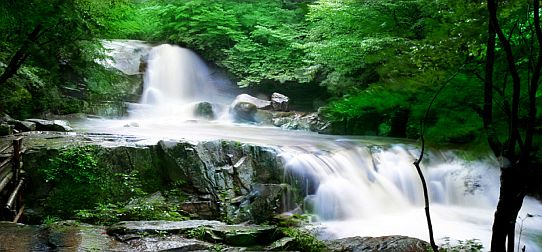Sharp Travel & Tours Inc.
Contact Info
Telephone - 847.759.8813
Toll Free - 1.888.To.Sharp
Email - sharptour@hotmail.com
Popular Destinations
STANDARD GROUP TOURS
DAILY EXCURSIONS
AMT RECOMMENDATIONS

Also called as Mt. Seolsan and Mt. Seolbongsan, the mountains were named Seorak because the snow would not melt for a long period of time and its rocks stay white like snow. In November 1965, the Seoraksan Mountains district was designated as a Natural Monument preservation area.
Afterwards in December 1973, it was designated as park preservation area, and in August 1982, as a Biosphere Preservation District by UNESCO.
The park is spread about in 4 cities and counties, in Sokcho, Inje, Goseong and Yangyang. Featuring the highest peak Daecheongbong, the east side is called OeSeorak and the west is called NaeSeorak, which is divided again into North NaeSeorak and South NaeSeorak. North NaeSeorak is composed of Bukcheon stream, which flows to Ingyecheon stream and Baekdamcheon stream. There are numerous valleys in NaeSeorak.
Follow the Baekdamcheon Valley where all the streams meet and you will reach Baekdamsa Temple, which is known for its beautiful scenery. Follow upstream and there is Gayadong Valley and Suryeomdong Valley, and past Yeongsiam and Mangyeongdae there is Madeungryeong ridge(1,327m) that leads to Seorakdong. Follow Suryeomdong Valley and you will reach Waryong Waterfall and Ssangpok. Go up the mountain a bit more from here and you will reach Bongjeongam(1,224m above sea level). Once you mount Daecheong Peak you can view the mountain peaks, and the sunrise viewed from here will make your heart pious. South NaeSeorak directs the valley from the Oknyeotang area to Hangyeryeong.
Daeseung Waterfall north of Jangsudae is the most beautiful site of NaeSeorak, which is 88m high. On the south valley of Yongdaeri there is the Twelve Fairy Bathing Spring, Oktang Waterfall, and Yongtang Waterfall.
Cheonbuldong Valley is the main Valley of Seorak Mountain and is also called Seorak Valley. It was named Cheonbuldong because the many peaks on either side look like a lineup of a thousand Buddhist statues. It is also called Cheonbuldong because the peaks also look like Buddhist saints offering food sacrifices to Buddha. If you follow the waterway of Waseondae for about 300m, you’ll arrive at Biseondae. Travel 12 km further from here and you will arrive at Daecheongbong. There’s also Biseondae Munjudam, Ihodam, and the steep Guimyeonam.
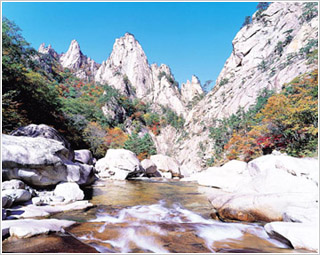
Gwongeumseong is the site of a castle ruins called Mt. Seoraksan, and it is also known as Mt. Onggeumsan Castle, or Toto Castle. It is located on the steep Dol Mountain of Mt. Seoraksan Sogongwon area. It is believed to have been built by the 23rd King of the Goryeo Period (918~1392), Gojong (1213~1259 reign). It is also called Gwon-Kim Castle, as there is a legend that two generals named Gwon and Kim, built the castle to avoid war.
At the left side of Sogongwon, past the Biryonggyo Bridge over the ravine, there is a path which leads to Gwongeumseong Castle, but it takes over an hour of travel through a steep, rocky path (2.5km), so cable cars are used. The cable car was installed by Dr. Gi-Sup Lee in 1971 and is still used by many tourists. It is operated from 7 a.m. to 6 or 6:30 p.m., departs every 7 minutes, and you can only purchase round-trip tickets at the ticket counter for that day. At the plateau of Gwongeumseong Castle there are 80 sections of rocks and you can see the East Sea and city of Sokcho. Also, to the west, you can see all kinds of fantastic rocks and stones which make up the Seoraksan Mountains.
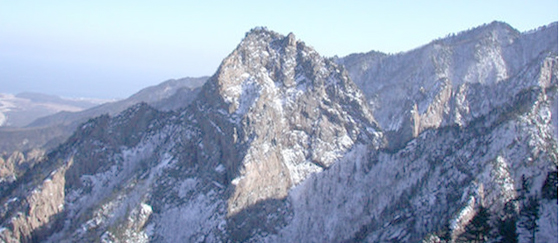
ANNUAL FESTIVALS
MT. SEORAK NATIONAL PARK
CHEONBULDONG VALLEY
GWONGEUMSEONG

SOKCHO ATTRACTIONS
The falling water of the loud and magnificent Biryong Fall looks very much like dragons flying up towards the sky, which is why it was named Biryong (flying dragon) Fall. There is a relatively wide path leading to Biryong Waterfall, through a bamboo forest, making it a very nice place to hike. From Biryonggyo Bridge, which is located in the lower reaches of Cheonbuldong Valley, called Ssangcheon, walk past it for about 30 minutes to the left, and you will see the Yukdam Falls, made up of 6 waterfalls and a deep pond. 300 m past this area (about a 20 minute walk), you can see the Biryong Falls between the narrow and rugged ravine. Also, if you follow the Towanggol, up a steep, rocky path, there is a huge, 3-tiered waterfall called Towangseong Falls, but due to the extremely dangerous path leading to it, it is barred to the public.
BIRYONG WATERFALL
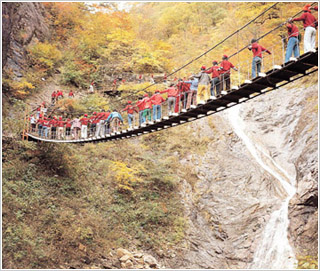
Seorak Waterpia is a theme park offering hot springs facilities and outdoor leisure activities together. Nestled in Seorak Hanhwa Resort at Mt. Seoraksan, Seorak Waterpia uses only pure Choeksan mineral waters, which is 49 degrees. It comes from the layer formed during the Mesozoic Era, and the water volume used per day is about 3,040 tons. With its abundance of cations (such as sodium, calcium, and magnesium) and anions (such as chlorine, carbonic acid, and sulphuric acid), hop spings are good for stess, neuralgia, arthritis, and geriatric diseases.
SEORAK WATERPIA THEME PARK
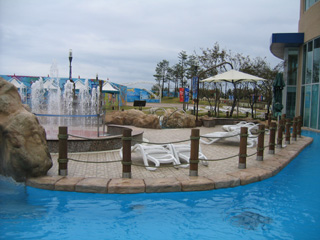
There are various facilities at Seorak Waterpia, which is the first hot springs resort opened in July 1997. You can enjoy the artificial waves at the Waves Pool, or the stream of the valley at the Stream Pool. At the theme zone, the Rafting Zone and Body Slider will give you thrill and fun. In addition, there were outdoor leisure spa facilities such as Lovers Bath, Rock Bath, and Cave Bath, and sauna facilities such as Prickle Bath, Wood Bath, Outdoor Bath, and so on. Its 18-hole golf course and many attractions of Seorak Plaza Land make here much more attractive to relax and have fun with your family than any other place.
You can see Sokcho Beach (450m long, 45-80m wide, average depth 1m) after about a 500m walk from Sokcho Express Bus Terminal. The scenery of its clear water, white sand and the pine forest is beautiful, and the nearby bus terminal makes transportation very convenient. It is also close to Seorak Mountain, and many hikers come by here as they go through Daecheongbong to Seorak-dong from inner Seorak area. The white sand is 2km long, extending through Cheongho-dong, Joyang-dong, and Daepo-dong.
SOKCHO BEACH
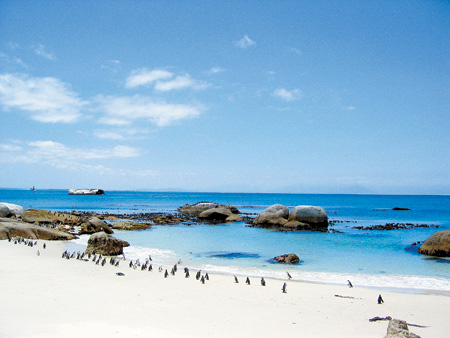
Sinheungsa is located 10 minutes walking distance from Sogongwon ticket counter, and many people visit because of its proximity to Sogongwon. Sinheungsa is a temple which used to be called Hyangseongsa, built by Jajangyulsa (590~658), who traveled to famous mountains all over the nation, in Queen Jindeok’s (?~654) 6th year of reign. It was wrecked and rebuilt many times since. On the path to Sinheungsa, there is a great bronze statue called Bronze Jwabul Statue, which is well over 10 meters high. ast the statue, which is on a granite terrace, to the right, there is a bridge called Hyeonsugyo, which was newly built for crossing the ravine.
SHINHEUNGSA TEMPLE
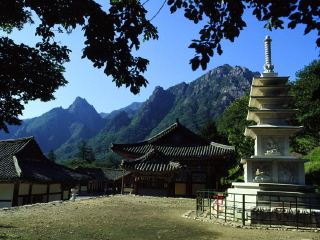
Past the bridge there is a long stone wall with a Cheongwang door, and you can enter the temple. At the entrance there are four Cheonwang (king) statues (Jiguk Cheonwang with a sword, Damun Cheonwang with a lute, Gwangmok Cheonwang with a tower, and Jeungjang Cheonwang with a dragon), placed on both sides. The Buddhist statues at Sinheungsa were placed here during the founding days of Seongjeongsa, and includes the statues Mireukbosal, Gwaneumbosal, Seji, etc. which were sculpted by Uisang Daesa. The buildings which were built during that time are still standing, like the sanctuary, main temple, Myeongbujeon, Bojaeru, and Chilseonggak, etc. There is also an important cultural property, Treasure No. 443, called Hyangseongsaji, a three-story stone tower.
You can reach the Ulsan boulder by following the wall outside Sinheungsa. Sinheungsa is an ancient temple with deep historical significance, and many tourists come because of its beautiful scenery.

On the opposite side, an hour’s walk past Chilseongbong, attached to Hwachaebong, is Chilseonggol’s forked road from which you can reach Oryeon Falls, Yangpok, Cheondang Falls and other valleys with exceptionally beautiful sceneries. The path used to be rough and difficult, but because of new facilities and a mountain villa, you can more easily climb and see the scenery of Cheonbuldong. Many people who go hiking at Seorak Mountain seek this place out because of the convenient transportation provided by Seorak-dong’s Sogongwon, which becomes the starting point for many mountain climbers, and there is an endless line of hikers and tourists who come to visit during mid October when the autumnal leaves start turning color.
The area open to the public is 0.45 Km long, 75m wide, making it about 9,000 pyeong, and more and more people come to visit because of the superb quality of the sand.
Sokcho beach plays an important role in displaying Sokcho-si as a great tourist area along with Seorak Mountain, Cheoksan Hot Springs, Cheongchoho, and Yeongrangho etc. On the bulwark, to the left of the beach, there are many places where you can enjoy hwaleo hoe (fresh sashimi). You can also enjoy sea fishing by taking a boat to Jo Island in the open-sea by the beach.
POPULAR DESTINATIONS
© 2008 Sharp Travel and Tours Inc.
